Overview
This tutorial guides you through automating the employment contract process using SignatureAPI integrated with Microsoft tools such as Forms, Power Automate, OneDrive, and Dataverse. You will build an automated workflow that begins when a new employee submits a form. The flow generates a personalized contract, sends it for signing using SignatureAPI, captures any information filled during signing, and stores the results automatically. HR is notified when the process is completed.What you’ll learn
- How to fill a document template with data using SignatureAPI.
- How to set up signature and input fields in your document.
- How to send documents to multiple signers using SignatureAPI.
- How to collect additional information from signers during the signing process.
- How to send documents for signature and track their status.
- How to retrieve the signed document and save it.
Tools you’ll use
- SignatureAPI – to generate, send, and manage signing workflows. SignatureAPI handles document generation, signature requests, tracking, and document delivery.
Get Your Free Test API Key
Sign up for a free account to get your test API key. Use it to generate non-binding envelopes and test your integration with SignatureAPI.
- Microsoft Power Automate – to build and automate the workflow.
- Microsoft Forms – to collect employee information.
- OneDrive – to store your DOCX template and signed contract (other document repositories also work).
- Microsoft Dataverse – to store employee data.
- Microsoft Outlook – to send notifications (other email providers also work).
Flow overview
The flow follows these steps:- Trigger – A Microsoft Forms submission starts the flow.
- Data Retrieval – Employee details are pulled from the form, and the contract template is fetched from OneDrive.
- Signature Process – An envelope is created in SignatureAPI, recipients are added, and the DOCX template is filled and sent.
- Monitoring – The flow waits until all parties have signed.
- Storage & Notification – The signed contract is saved to OneDrive, employee data is stored in Dataverse, and HR is notified by email.
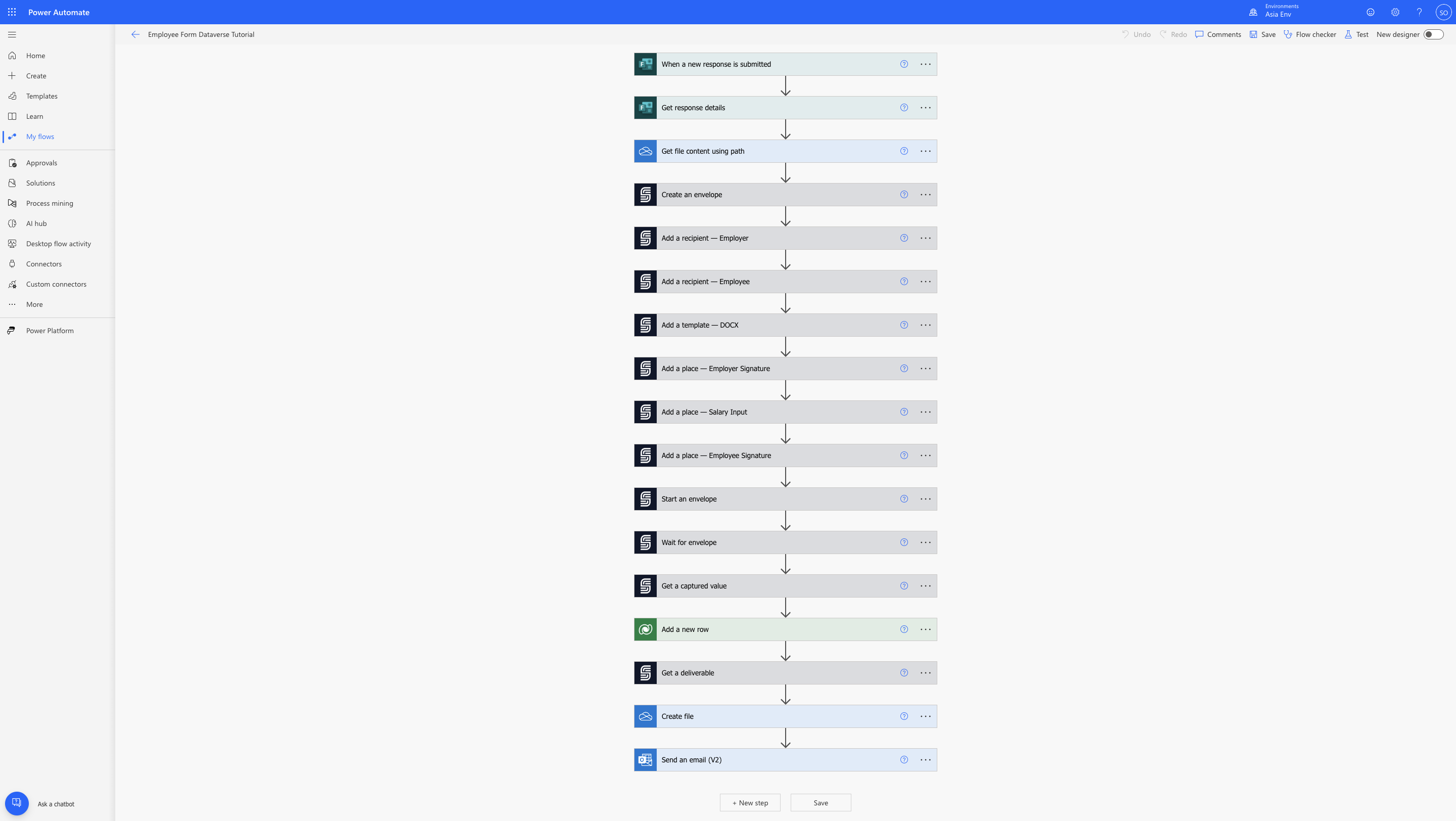
Prepare the contract template
Begin by preparing your employment contract template in DOCX format. This template is used to generate personalized contracts. You need to add two types of annotations to your document: template fields and placeholders. Template Fields Template fields insert data into the document before it is sent to recipients. These fields are marked with double curly brackets, for example:{{employee.first_name}}.
SignatureAPI replaces these fields with actual values when generating the document.
Learn more about document templates.
Placeholders
Placeholders mark where recipients should sign or enter information during the signing process. These are identified by double square brackets, for example: [[employee_signature]].
Learn more about placeholders.
In this tutorial, we will:
- Use template fields to fill in employee details.
- Define signature places for both the employer and the employee using placeholders.
- Add a text input place for the employer to enter the salary using a placeholder.
- Open your existing employment contract (DOCX) in Microsoft Word.
- Locate where employee details should be inserted (e.g., name, email).
- Add template fields using double curly brackets, for example:
- First name:
{{employee.first_name}} - Last name:
{{employee.last_name}} - Email:
{{employee.email}}
- First name:
- Add placeholders for signatures using double square brackets, for example:
- Employer signature:
[[employer_signature]] - Employee signature:
[[employee_signature]]
- Employer signature:
- Add a placeholder for salary input:
[[salary_input]] - Save the template and upload it to OneDrive (or another supported storage service).
In the example shown below, placeholders and template fields are colored blue for visibility. In your final document, we recommend coloring them white so they are hidden from recipients.

Create the Microsoft Form
We use Microsoft Forms to collect employee details such as name and email address.- Visit Microsoft Forms and sign in.
- Click New Form.
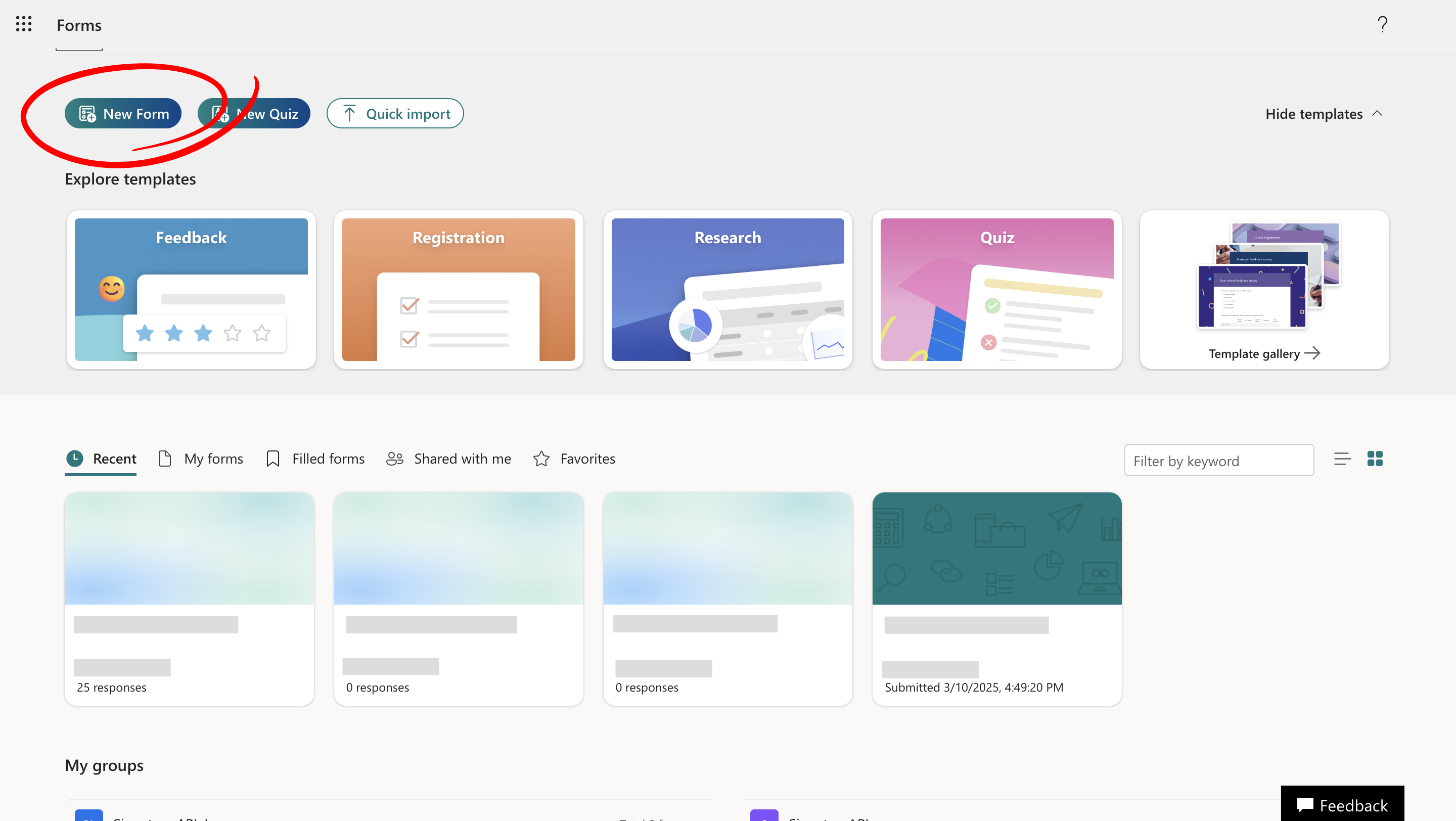
- Name your form and add the following required questions:
- First Name (Text, required)
- Last Name (Text, required)
- Email Address (Text, required)

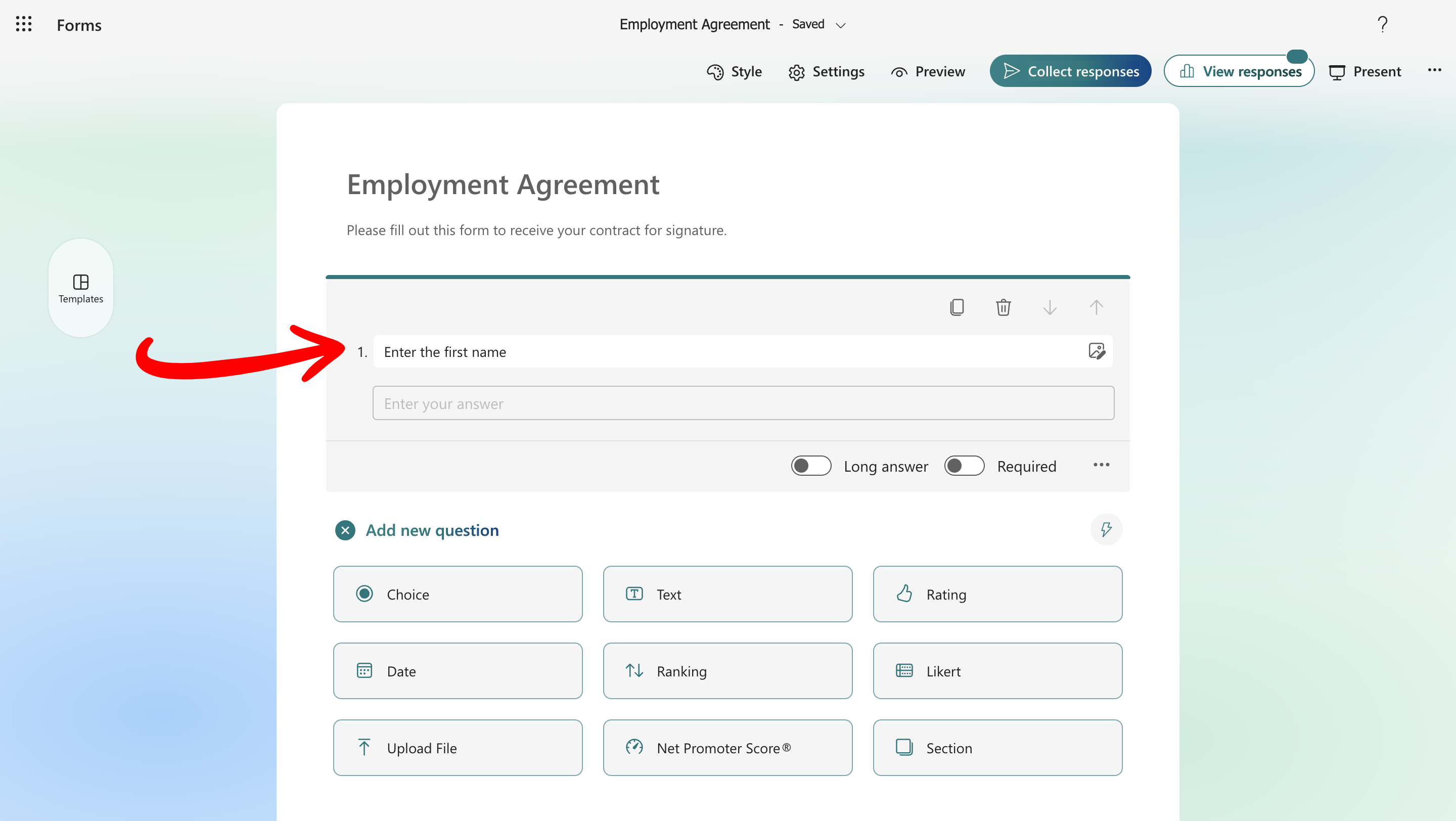
- Save and publish your form.
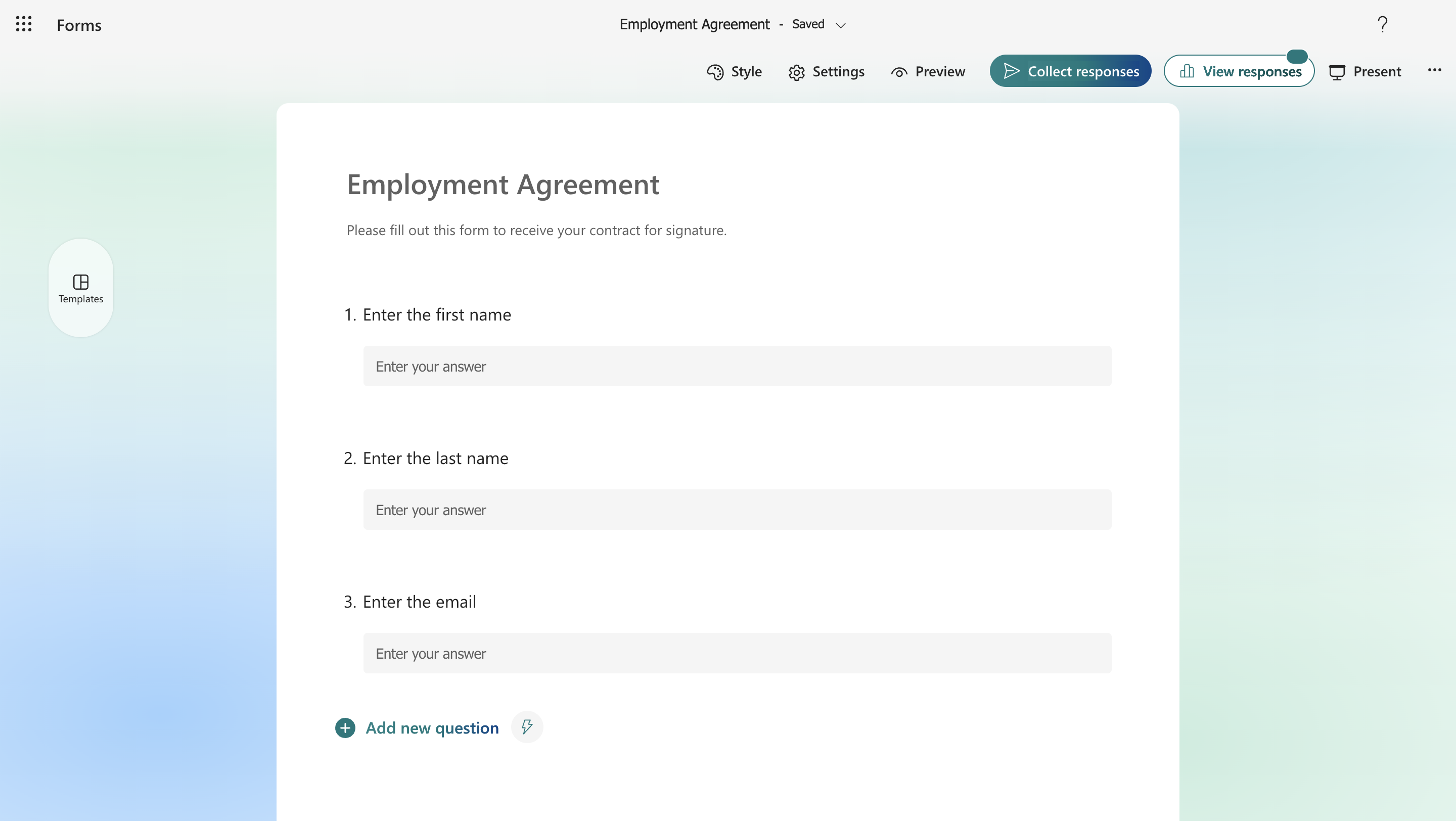
Create the Dataverse table
We will store employee details in a Dataverse table.- Go to Power Apps and sign in.
- In the left menu, click on “Tables”.
- Click Start with a blank table.
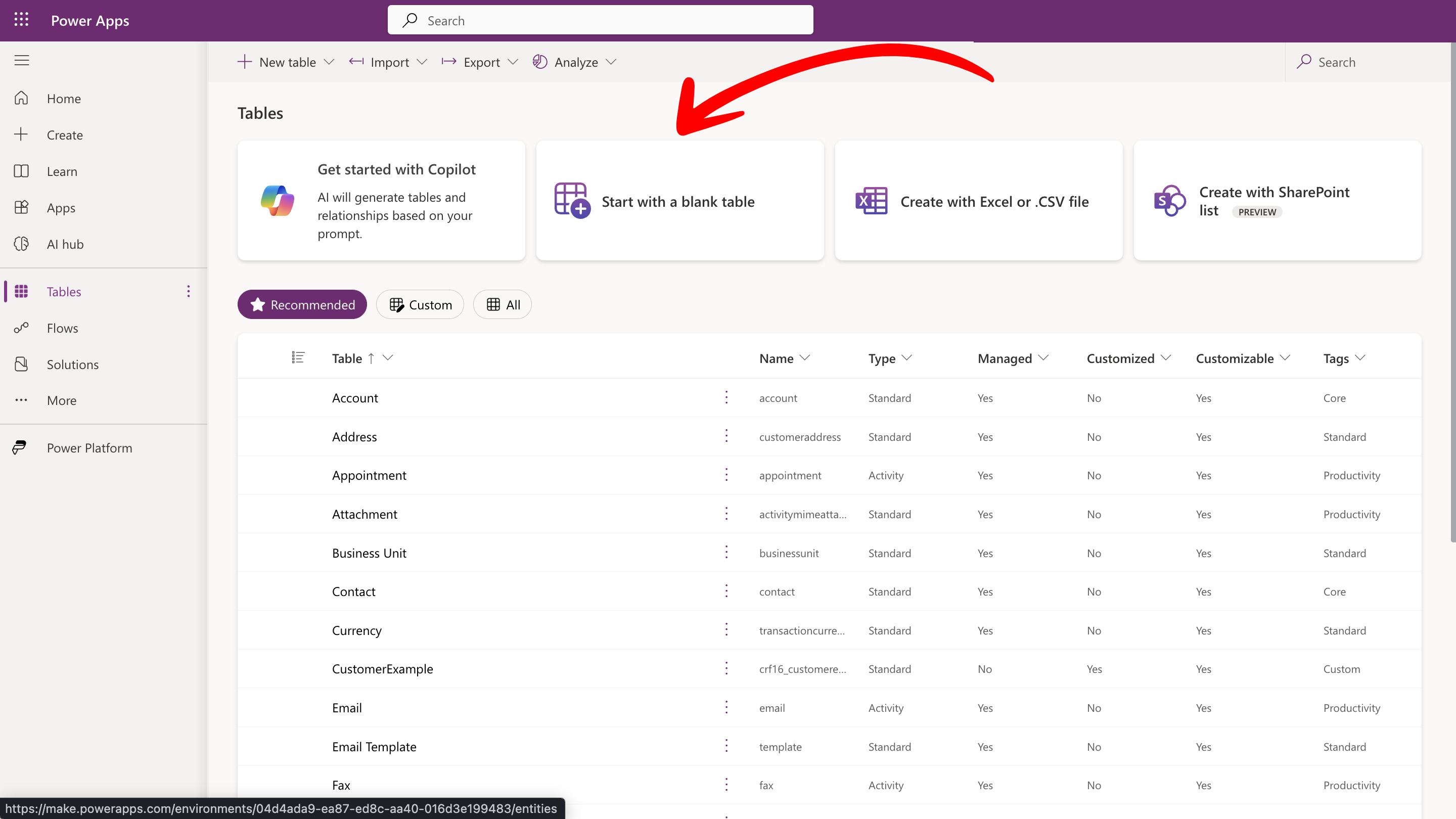
- Add the following columns, all with Text format and Required:
- First Name
- Last Name
- Email Address
- Salary Amount
- Signature Completion

- Rename the table:
- Click Properties, then enter a new name (e.g., Contracts).
- Change the Primary column to Email Address.
- Click Save and exit.
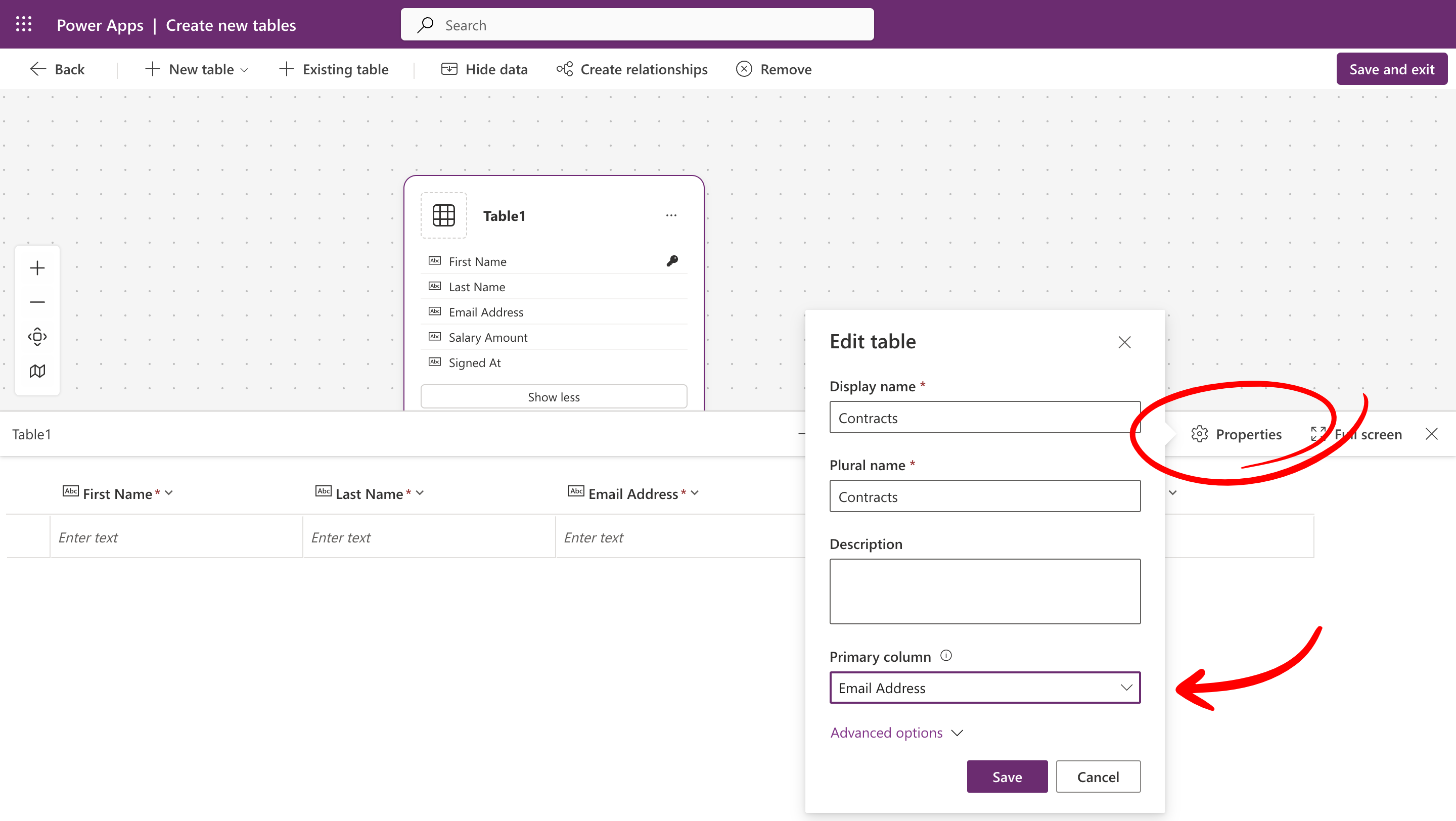
Build the Power Automate flow
Now that you have the contract template, the form, and the Dataverse table set up, create a Power Automate flow that runs whenever someone submits the form.Configure the trigger
Set up the flow trigger so it runs when a new form response is submitted.- Go to Power Automate and select Automated Cloud Flow.
- Choose the trigger “When a new response is submitted” from the Microsoft Forms connector.
- Click Create.
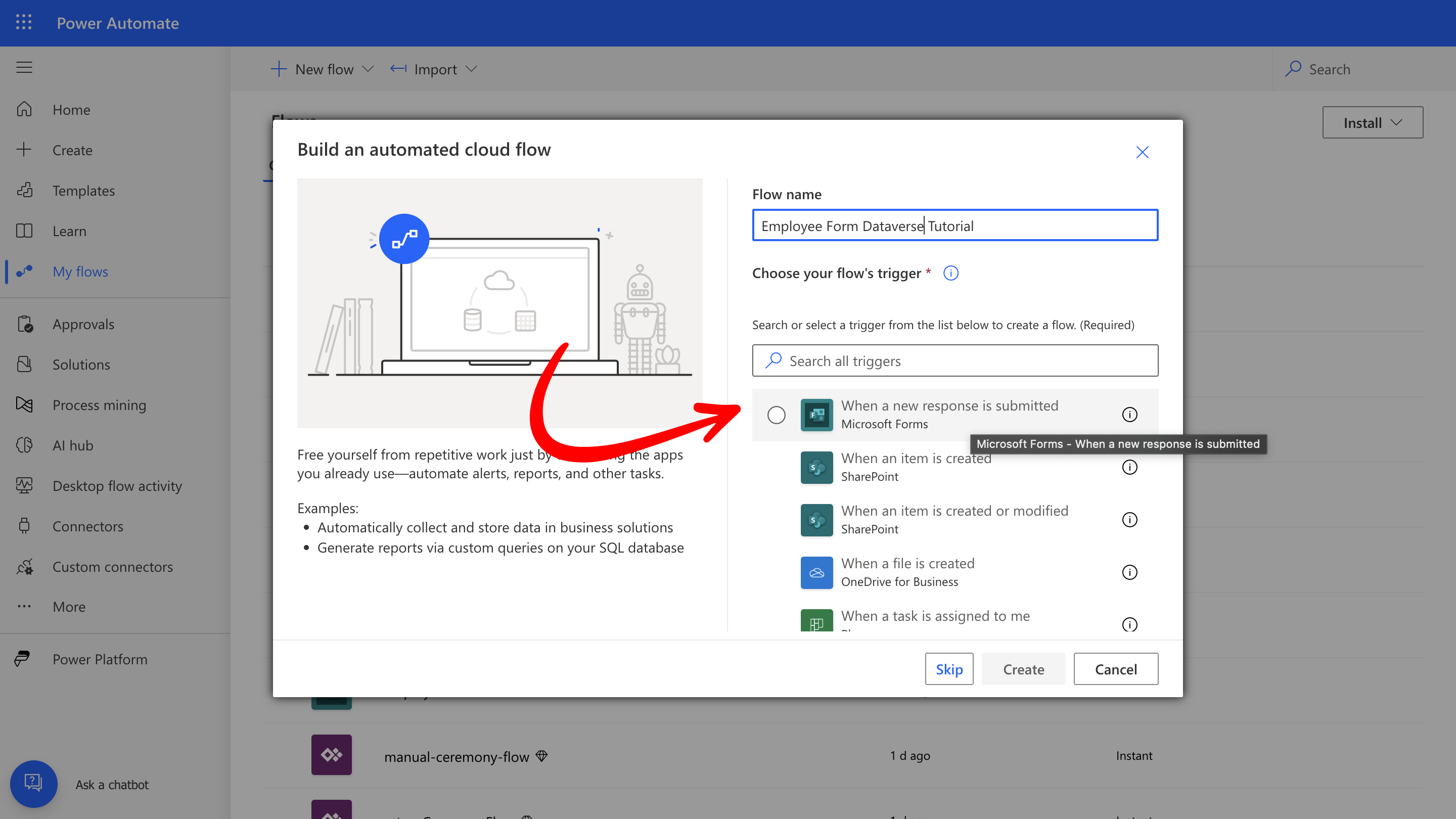
- In the Form Id field, select your form from the dropdown.
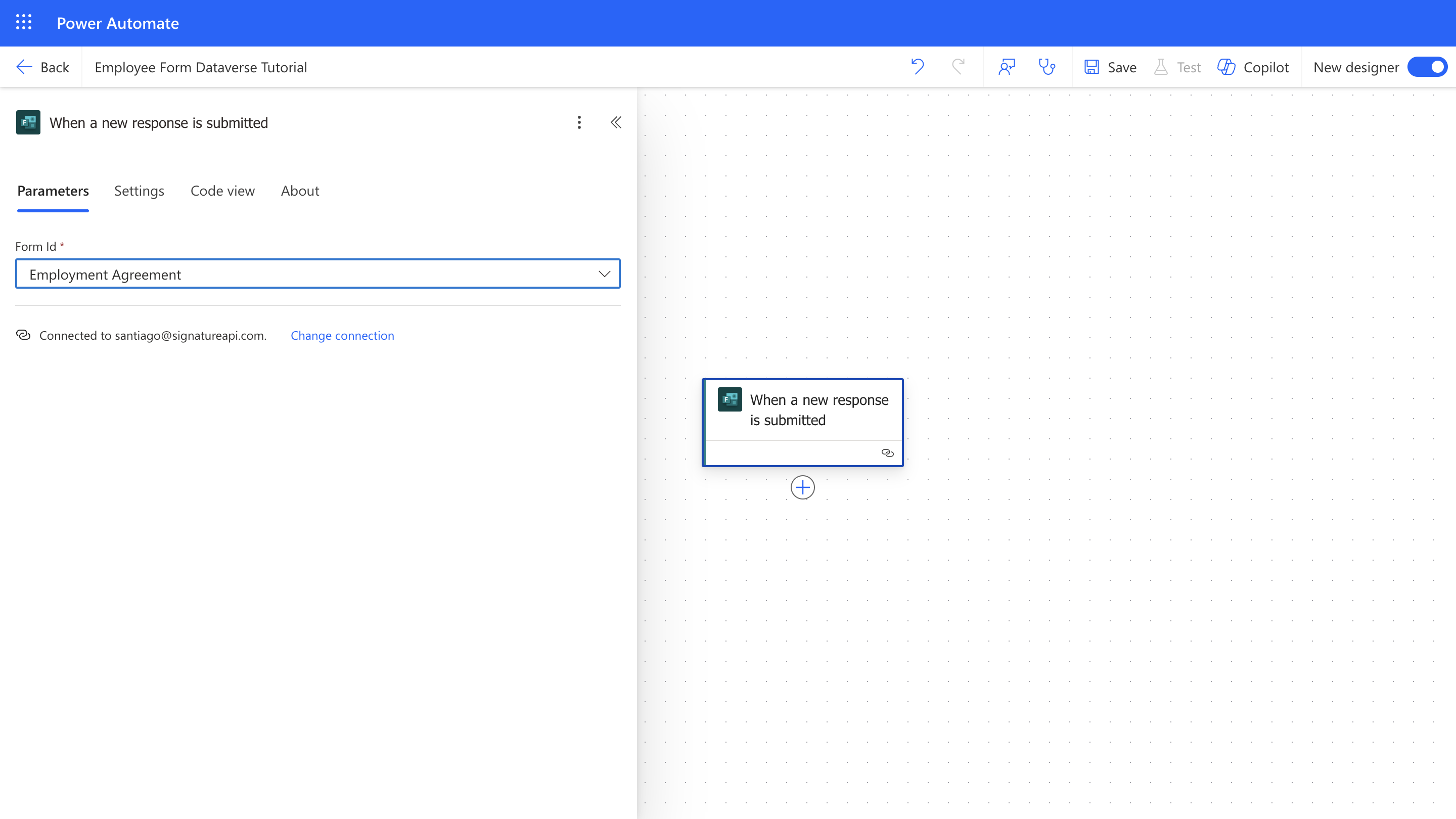
Retrieve form response details
Get the details submitted by the employee.- Add the Get response details action from the Microsoft Forms connector.
- In the Form Id field, select the same form.
- In the Response Id field, select Response Id from the trigger step.
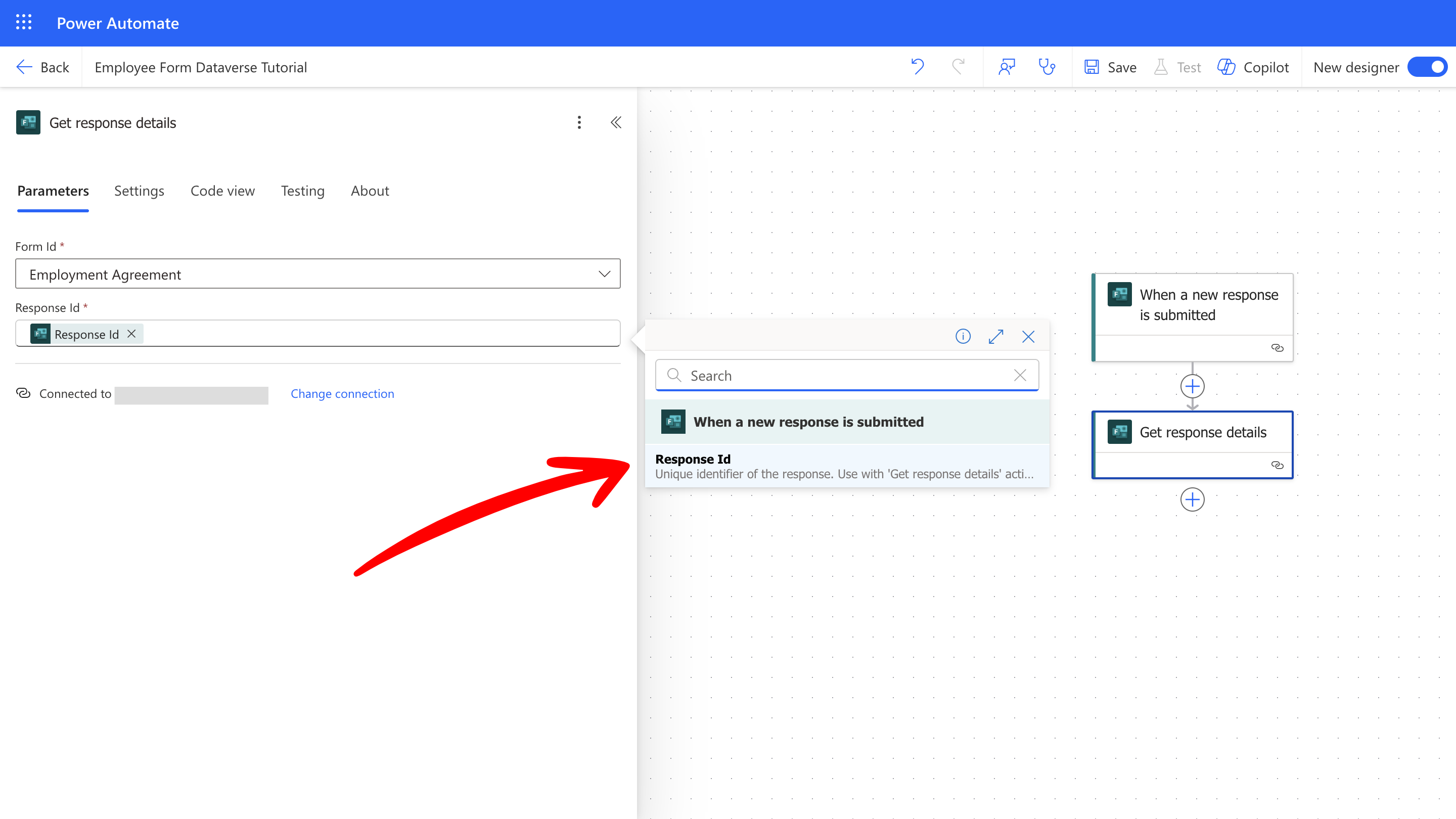
Retrieve the contract template from OneDrive
Fetch the contract template stored in OneDrive.- Add Get file content using path from the OneDrive connector.
- In the File Path field, select the DOCX template you uploaded.
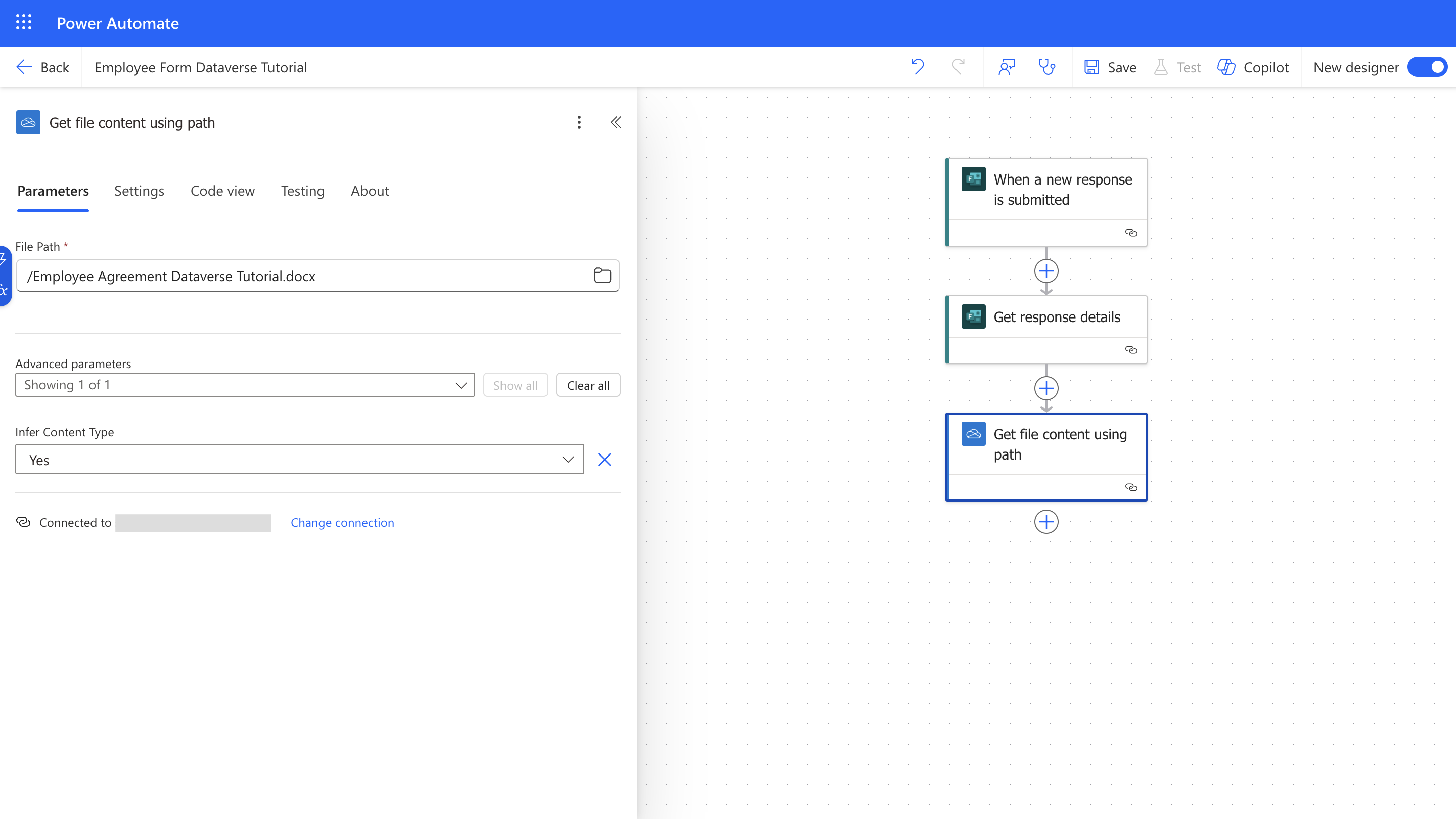
Create an envelope
In SignatureAPI, an Envelope is a container that holds one or more documents to be sent to recipients. It defines and manages the signing process for those documents. Start by creating the envelope in your flow:- Add the Create an envelope action from the SignatureAPI connector.
- If this is your first time using the connector, you’ll be prompted to enter your SignatureAPI API key. Learn more about authentication and connections.
- Set an Envelope Title and include a message to recipients. You can use dynamic data from earlier steps.
- In Advanced parameters, set Envelope Routing to Sequential. This ensures the employer signs first, followed by the employee.
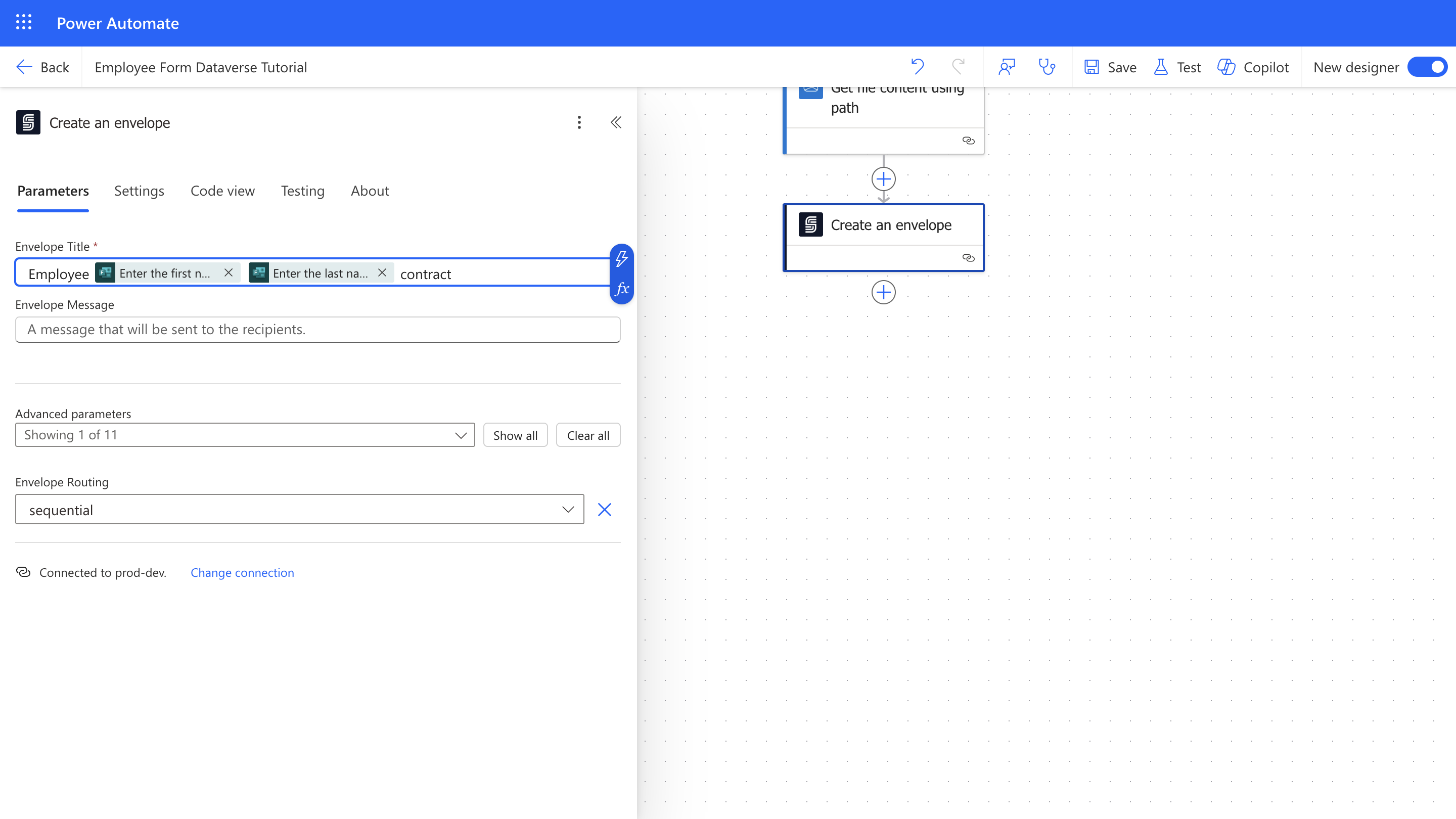
Add the employer as a recipient
Add the first recipient — the employer.- Add the Add a recipient action from the SignatureAPI connector.
- Rename the action to Add a recipient – Employer to keep things organized.
- Set the Recipient Name and Recipient Email (e.g., “John Doe” and “john.doe@example.com”).
- Set the Recipient Key field to
employer. You’ll reference this key when assigning signature places.
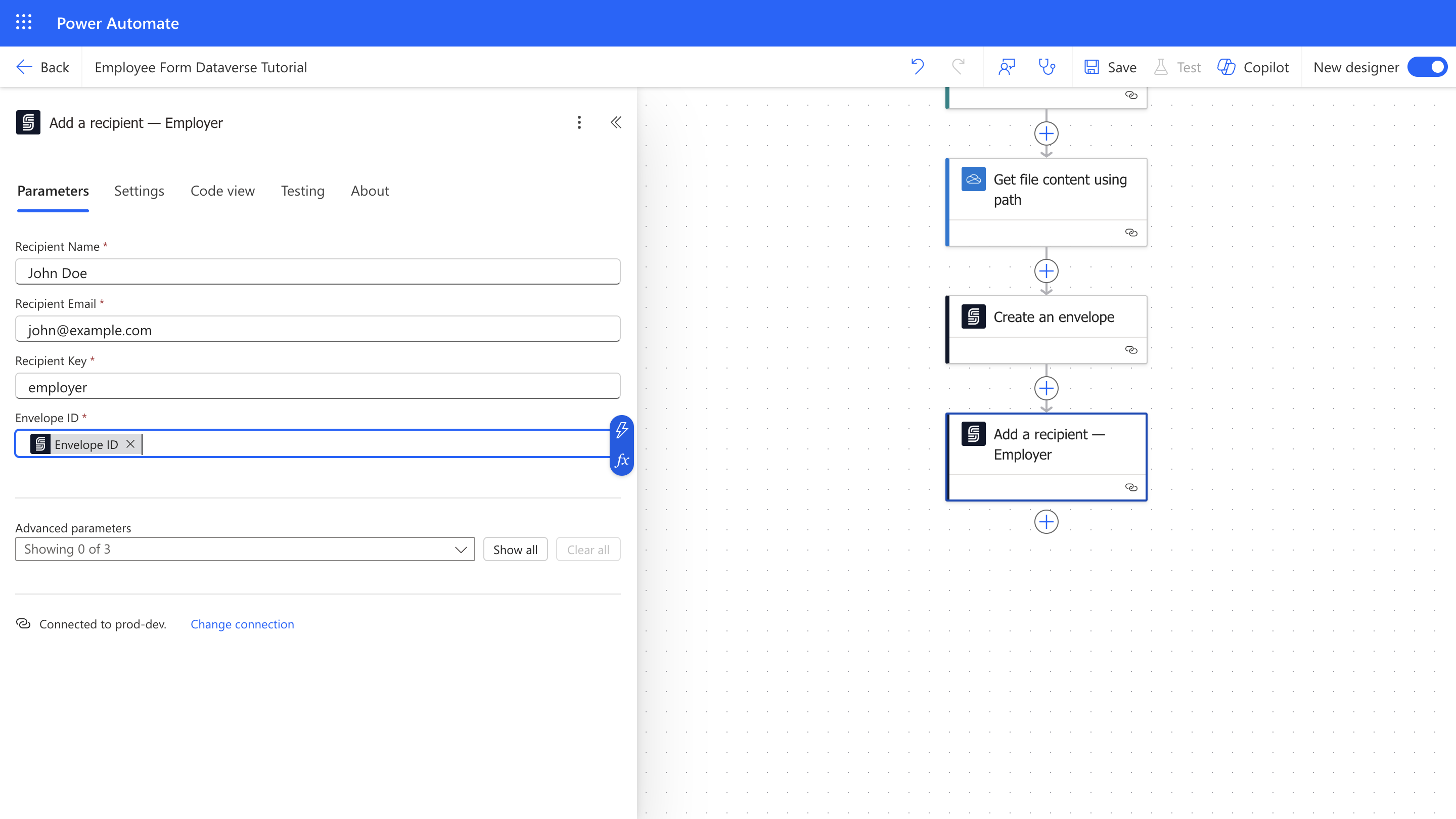
Add the employee as a recipient
Add the second recipient — the employee.- Add the Add a recipient action from the SignatureAPI connector.
- Rename the action to Add a recipient – Employee.
- Set the Recipient Name and Recipient Email using dynamic content from the Get response details step.
- Set the Recipient Key field to
employee.
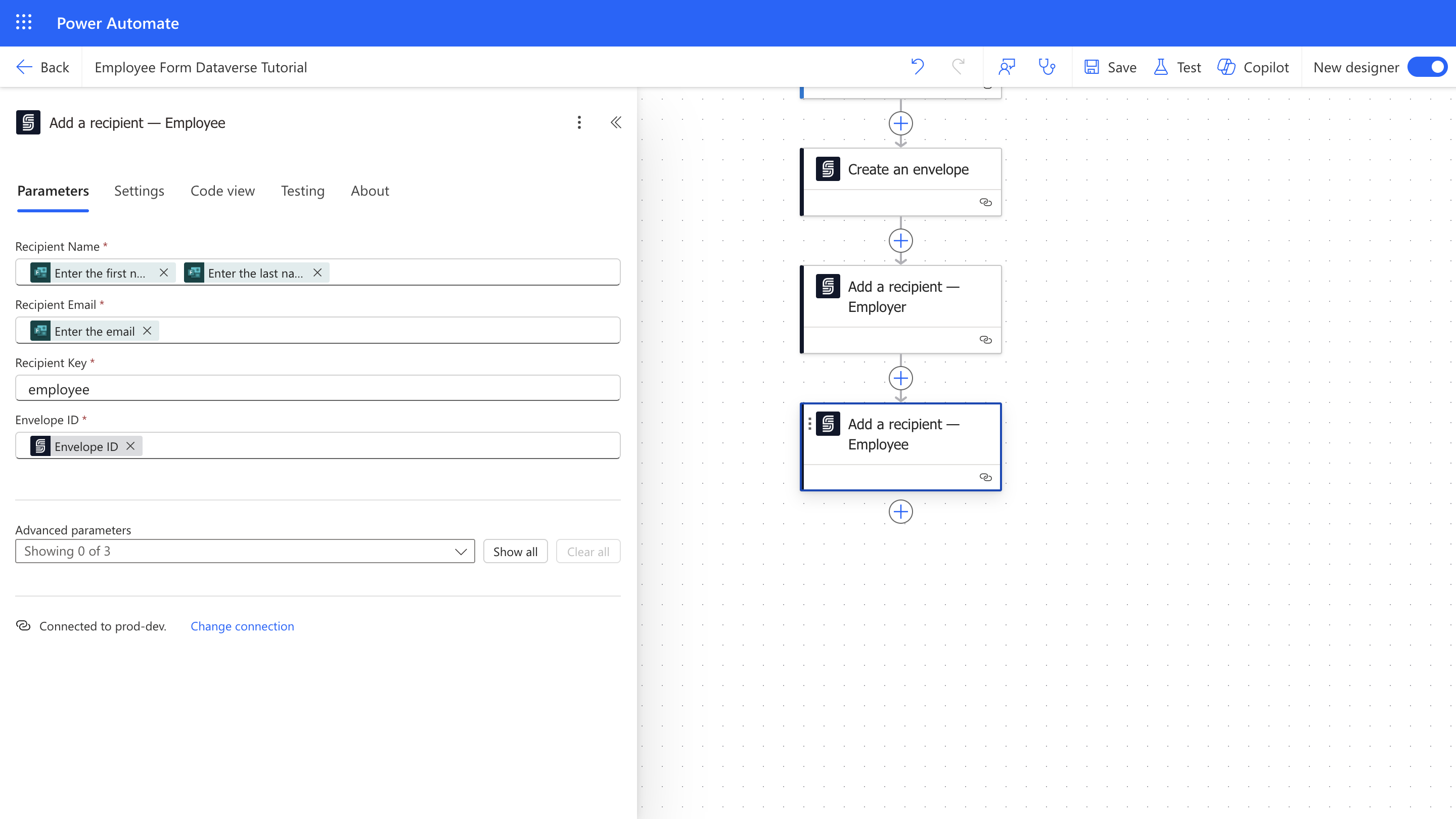
Add the contract template
Next, add your contract template to the envelope and populate it with employee data.- Add the Add a Template – DOCX action from the SignatureAPI connector.
- In the File Content field, select the File Content output from the Get file content using path action (OneDrive).
- (Optional) Set a Document Title.
- Use the Template Data array to fill in the template fields. For each field, add a Template Data Item in
key: valueformat.
{{employee.first_name}} with the value “Richard Roe”, set the item as employee.first_name: Richard Roe.
You can use dynamic content from earlier steps to set values for each template field.

Add a signature place for the employer
When preparing the template, you set a placeholder[[employer_signature]] to indicate where in the document the employer will sign.
Now, add a Signature place to the document and associate this placeholder with the employer. Use the placeholder key employer_signature to identify the place in the document and the recipient key employer to identify the recipient.
- Add “Add a place – Signature” action from the SignatureAPI connector. Rename it to Add a place – Employer Signature for clarity.
- Set the Place Key field to the placeholder key used inside the document (without square brackets), for example,
employer_signature. - Set the Recipient Key field to
employer, matching the recipient key you set earlier. - Set the Document ID field to the Document ID from the previous Add a Template – DOCX action.
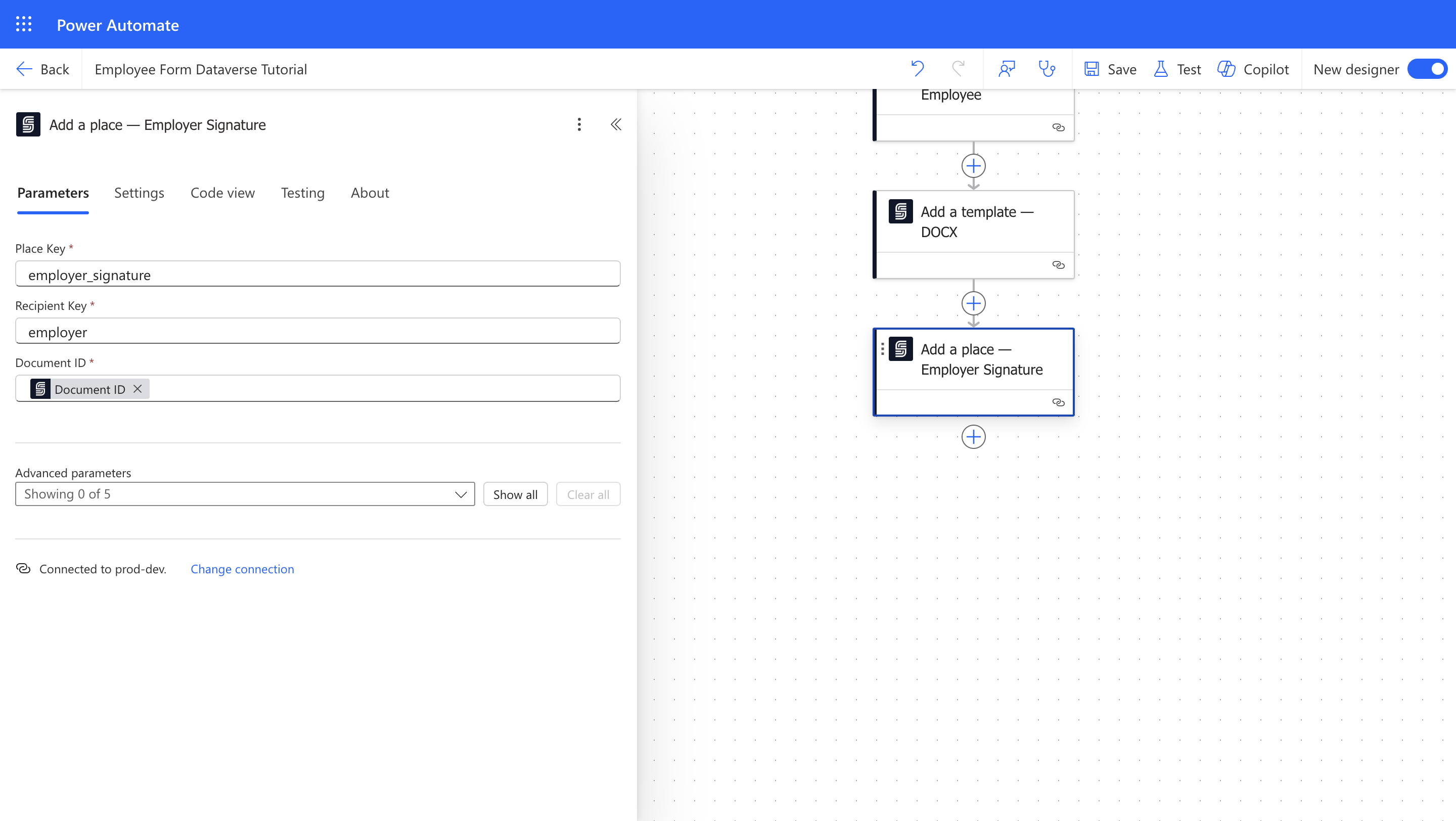
Add the salary input for the employer
In a similar way, add a Text Input Place to link the[[salary_input]] placeholder in the document with the employer.
To access this value programmatically and add it to the Dataverse table later, capture this value by setting the Capture As field (in advanced parameters). Learn more about captured values.
- Add an Add a place – Text Input action from the SignatureAPI connector. Rename it to Add a place – Salary Input.
- Set the Place Key field to the placeholder key used inside the document (without the square brackets), for example,
salary_input. - Set the Recipient Key field to
employer, as before. - Set the Document ID field to the Document ID from the previous Add a Template – DOCX action.
- To retrieve the value filled by the employer, set the Capture As field to
salary_input. This allows you to retrieve this value later in the flow.
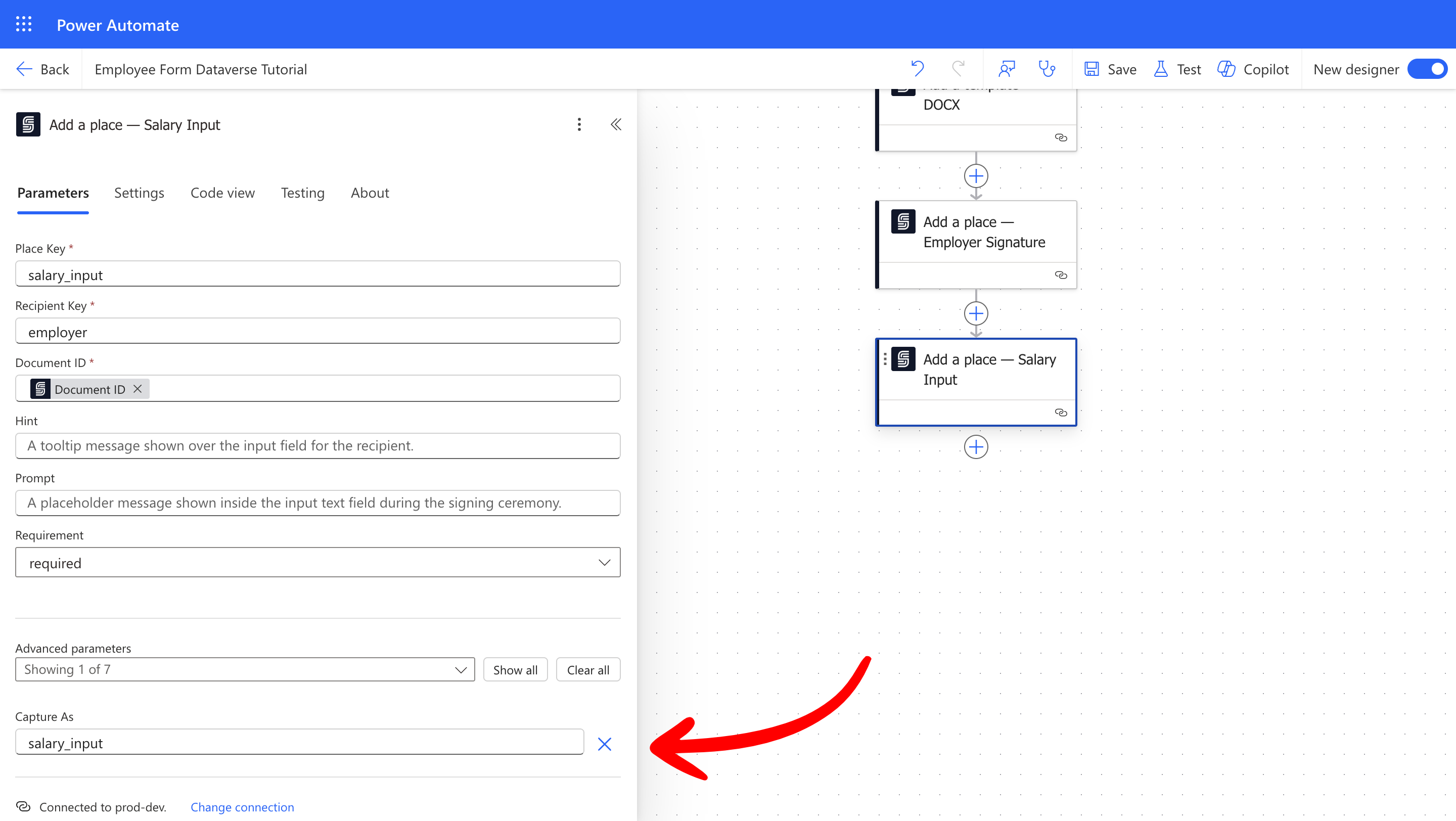
Add a signature place for the employee
As you did for the employer, add a Signature Place for the employee.- Add “Add a place – Signature” action from the SignatureAPI connector. Rename it to Add a place – Employee Signature for clarity.
- Set the Place Key field to the placeholder key used inside the document (without the square brackets), for example,
employee_signature. - Set the Recipient Key field to
employee, matching the recipient key you set for the employee. - Set the Document ID field to the Document ID from the previous Add a Template – DOCX action.

Start the signing process
This step indicates the envelope is ready to be sent for signing. At this point, the envelope is fully assembled and sent to recipients.- Add “Start Envelope” action from the SignatureAPI connector.
- Set the Envelope ID field to the Envelope ID output of the Create an Envelope action.
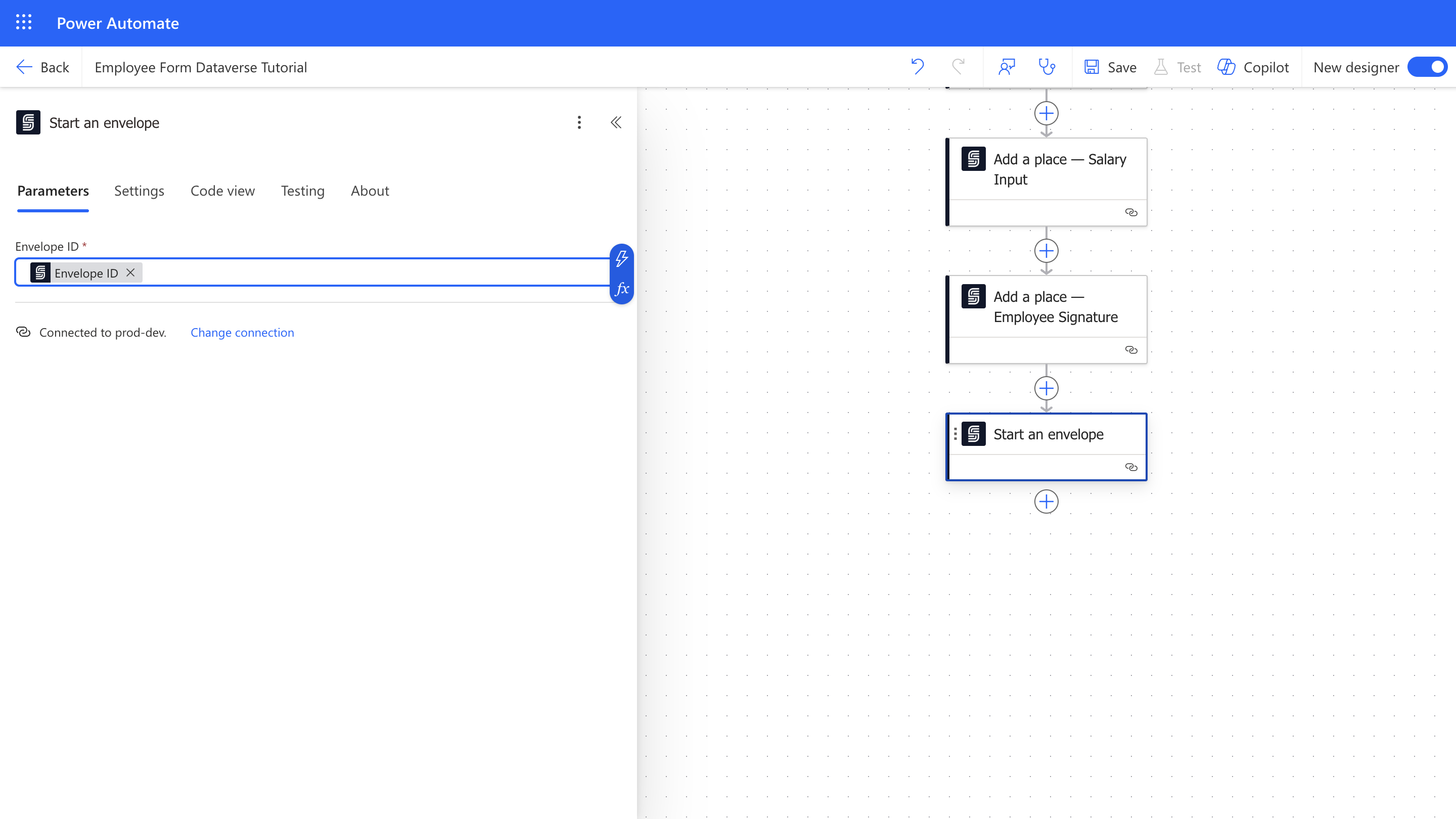
Wait until all recipients have signed
Use the Wait for envelope action to pause the flow until all recipients have signed the document.Use Wait for envelope only if you expect fewer than 100 pending envelopes at once, and if you expect recipients to sign soon, since Power Automate actions cannot run for more than 30 days. For more flexibility, consider the trigger When a deliverable is generated instead.
- Add “Wait for envelope” action from the SignatureAPI connector.
- Set the Envelope ID field to the Envelope ID output of the Create an Envelope action.
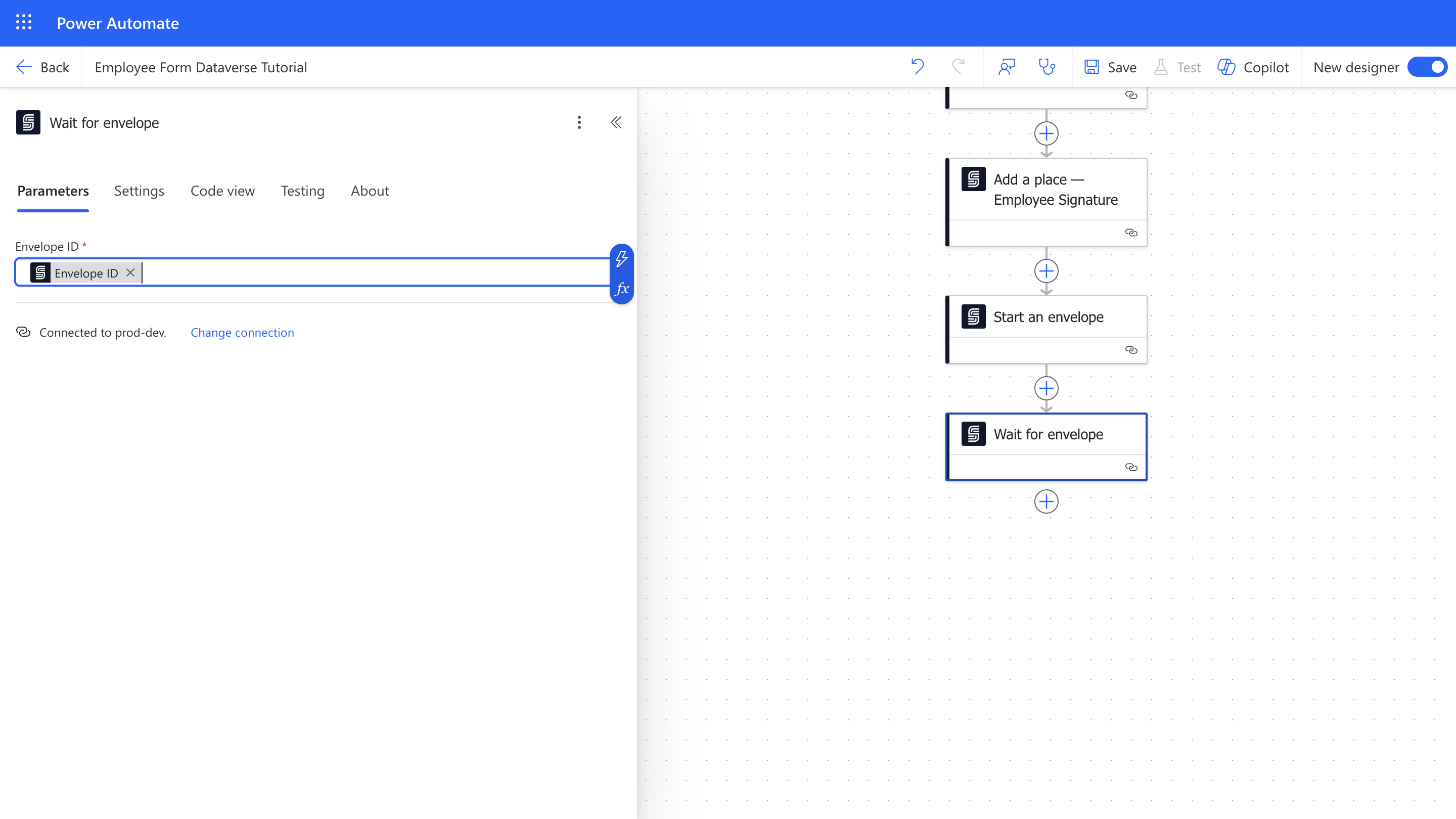
Get the captured salary input
At this point in the flow, recipients have signed, the envelope is completed, and the deliverable (the signed document) is generated. You can now retrieve the captured value from the salary input field the employer filled during the signing ceremony.- Add Get a captured value action from the SignatureAPI connector.
- Set the Envelope ID field to the Envelope ID output of the Create an Envelope action.
- In the Capture Key field, set the same key you used in the Add a place – Text Input action (in this case
salary_input).
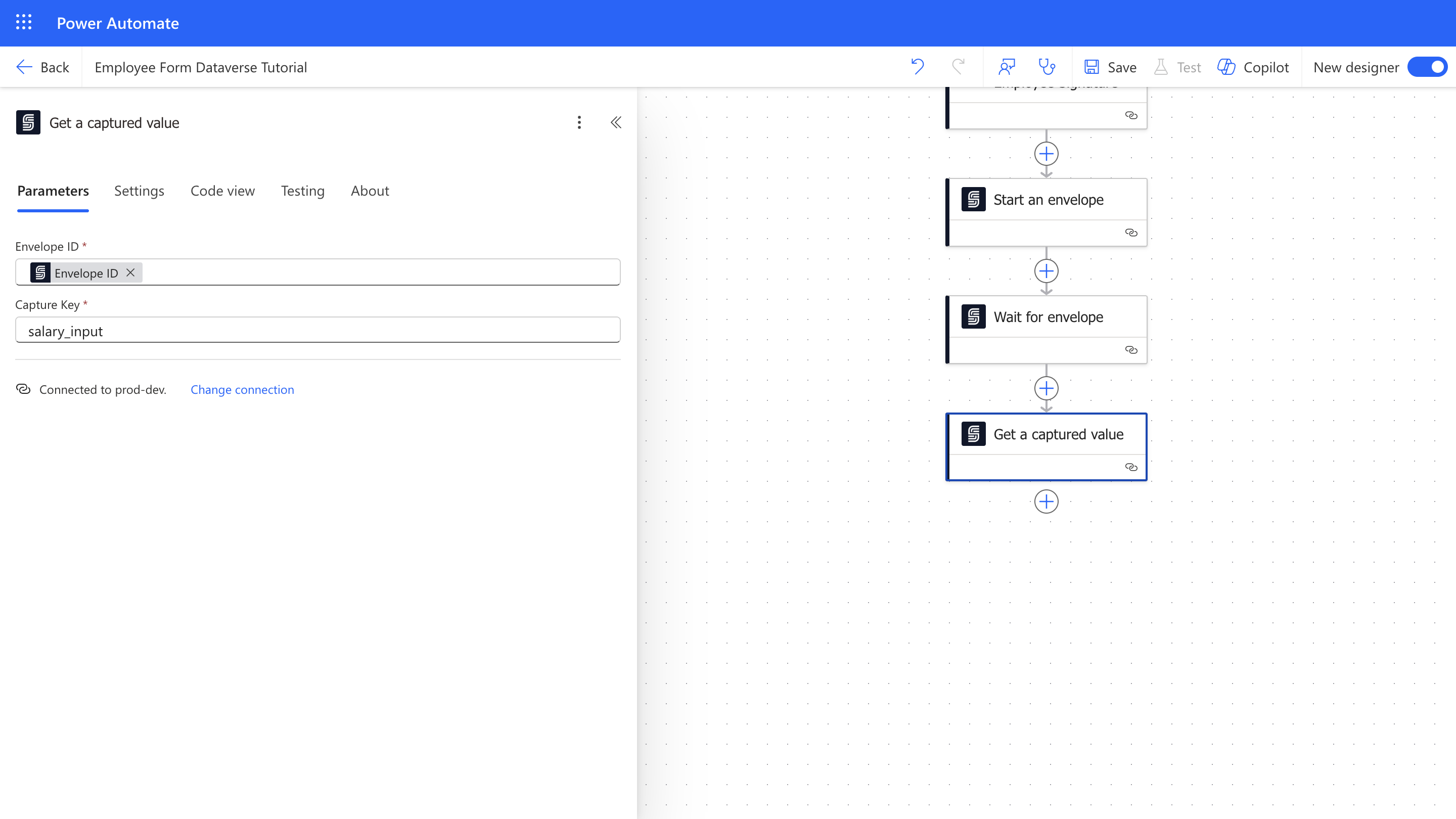
Add a row to the Dataverse table
Now, add a row to the Dataverse table using the employee details and the captured salary amount.- Add Add a new row action from the Micorosft Dataverse connector.
- In the Table name, select the table you created earlier (for example, Employee Contracts).
- From the Advanced parameters, select the Fields to map to the employee details and the captured salary amount using dynamic content:
- Set the First Name, Last Name, and Email Address from the Microsoft Forms’ Get response details action.
- Set the Salary Amount from the captured value in SignatureAPI’s Get a captured value action.
- Set the Signed At from SignatureAPI’s Wait for Envelope action.
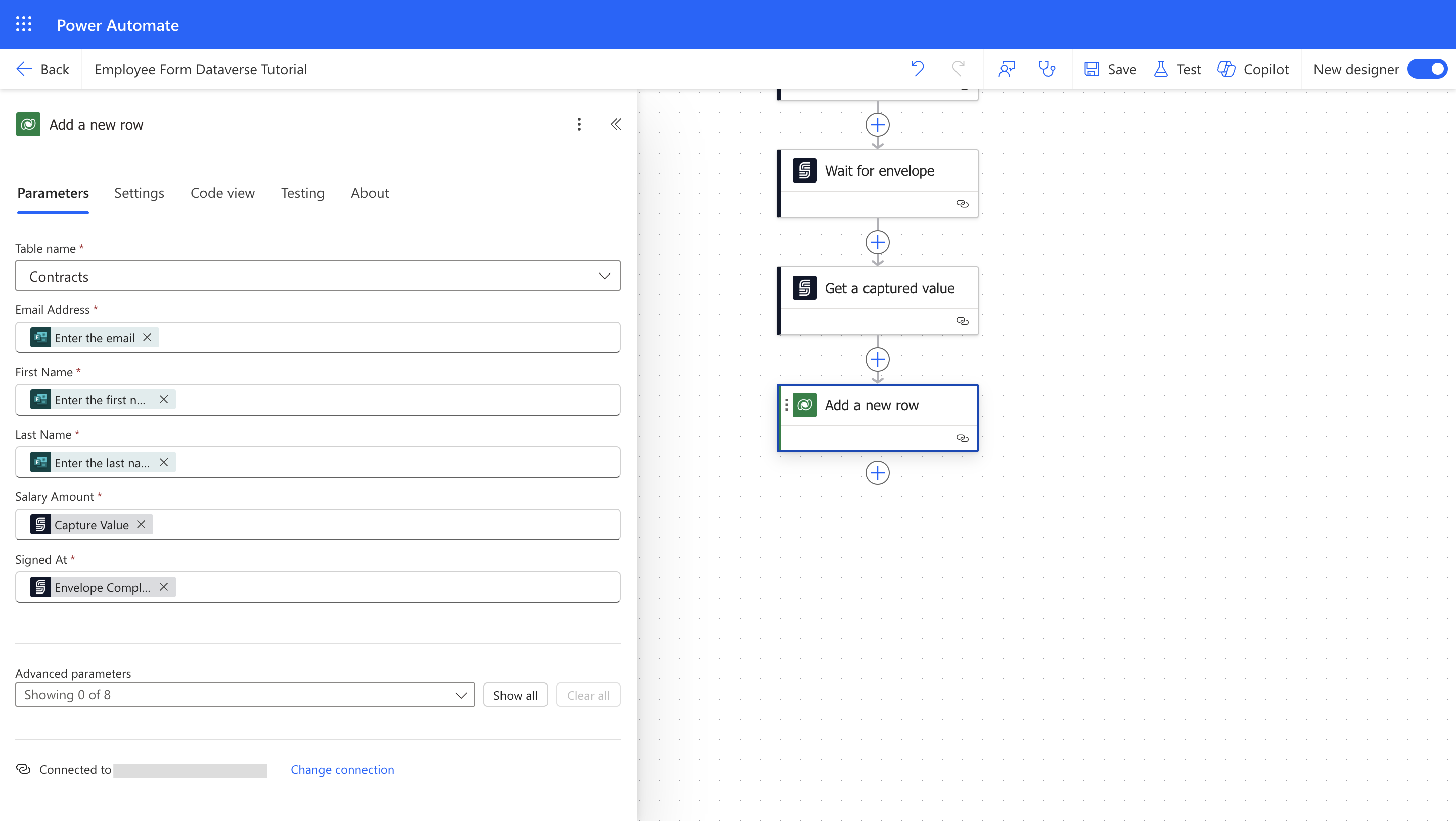
Retrieve the signed contract
In SignatureAPI, the deliverable is a PDF containing the signed documents and the audit log. See an example of a deliverable. Retrieve the deliverable so you can save it later.- Add a Get a deliverable action from the SignatureAPI connector.
- Set the Deliverable ID field to the Deliverable ID output of the previous Wait for envelope action.
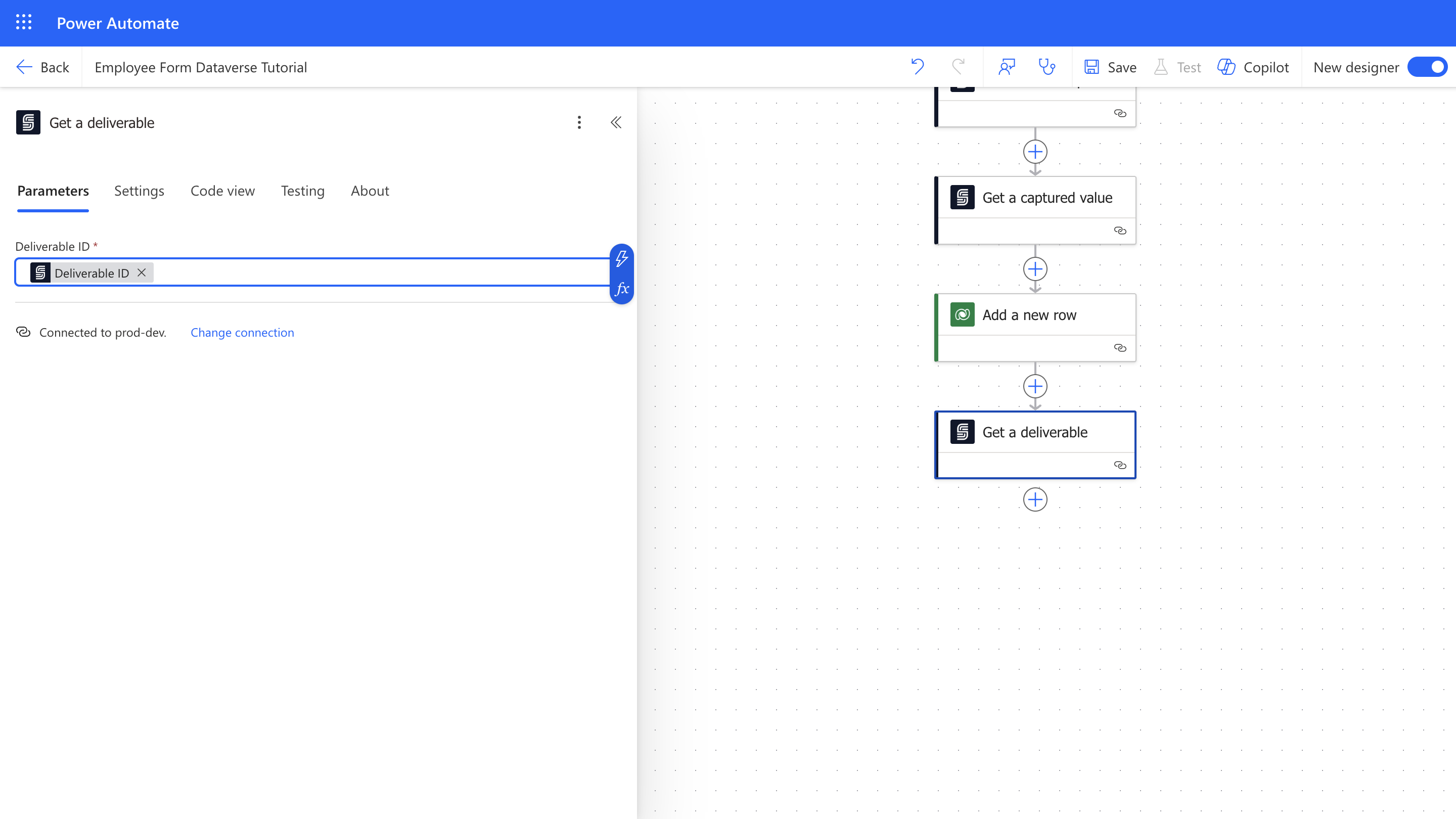
Save the signed contract to OneDrive
Now, save the signed contract to OneDrive.- Add Create File action from the OneDrive connector.
- Set the File Name field to your desired signed document name. You can use dynamic content from previous steps. Make sure to end it with
.pdf. - Set the File Content field to the File Content output of the Get a deliverable action.
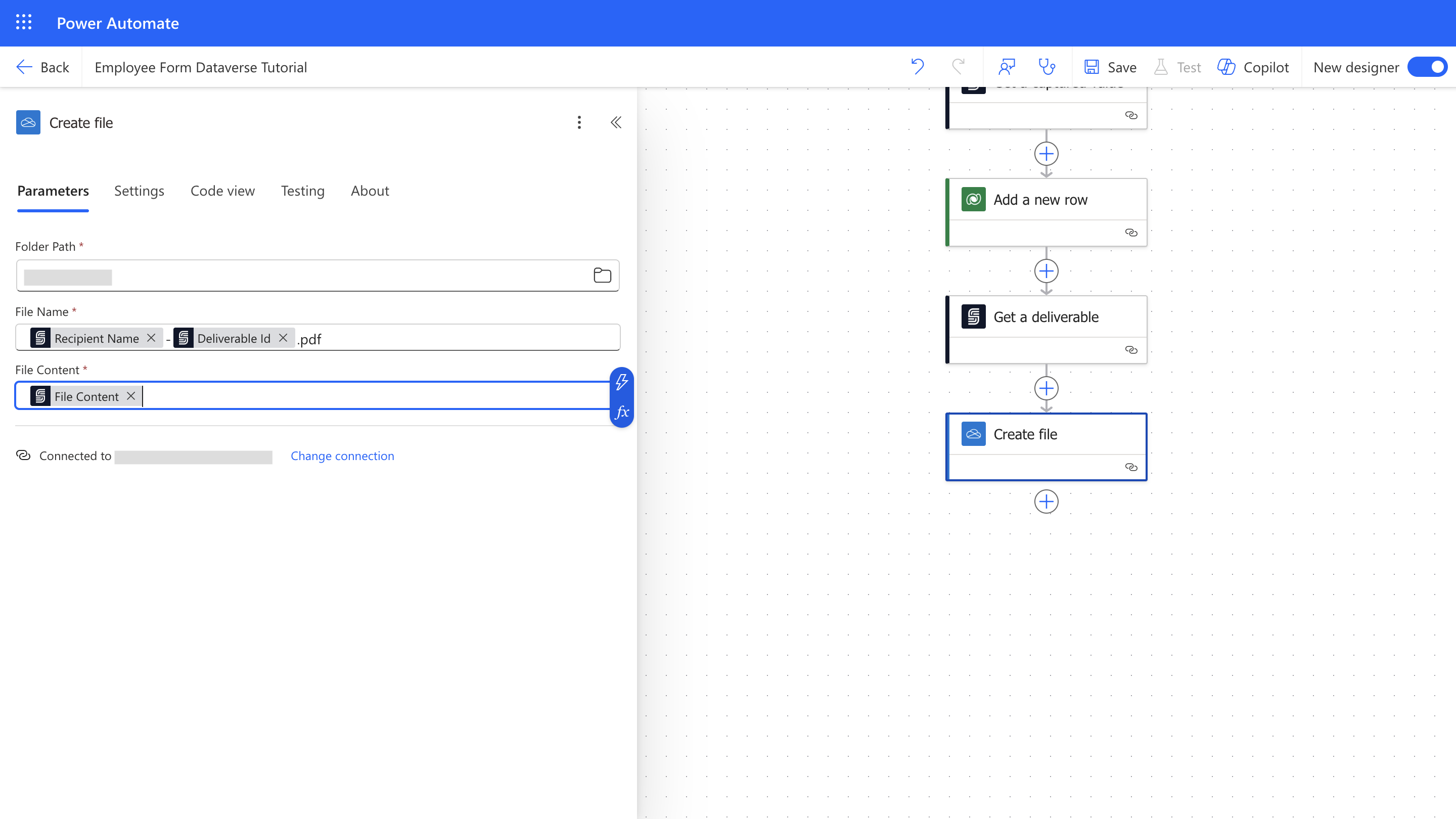
Notify HR that the contract was signed
Finally, notify HR that the contract was signed and attach the signed document.- Add Send an email (V2) action from the Outlook connector.
- Set the To field to the HR department email address.
- Set the Subject and Body as you prefer, and use dynamic content from previous steps as needed.
- Under Attachments in advanced parameters, set the attachment file name (ensure it ends with
.pdf) and set the Content field to the File Content from the Get a deliverable action.
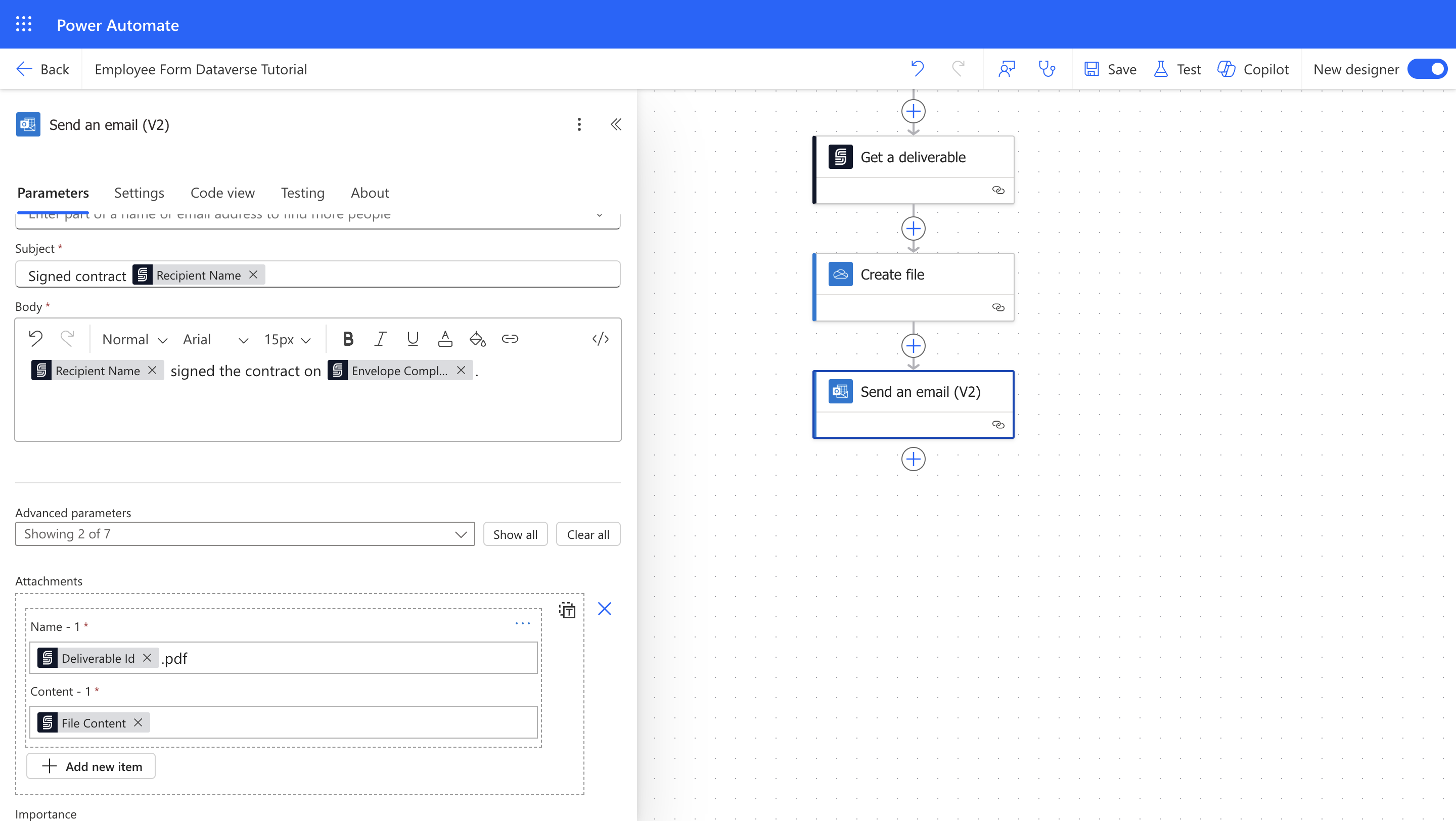
Test Your Automation
Test the entire process end-to-end.- Save your Power Automate flow.
- Submit a test response through your Microsoft Form.
- Verify each step:
- The form is submitted successfully.
- The flow is triggered and the contract is sent to the employer.
- After the employer fills the salary amount and signs, the employee receives and signs the contract.
- A row is added to the Dataverse table with the employee details and captured salary amount.
- The signed contract is saved in OneDrive.
- HR receives an email notification with the signed contract attached.
Conclusion
In this tutorial, you learned how to use SignatureAPI together with Microsoft Forms, Power Automate, OneDrive, and Dataverse to automate the employment contract process. You saw how to fill a document template, add signature and input fields, and send documents to recipients for signing. You also learned how SignatureAPI captures additional data from recipients, tracks the status of the envelope, and provides a signed deliverable once the process is completed. The tutorial showed you how to automatically save signed contracts and employee details, streamlining your workflow. With these steps, you can now use SignatureAPI to manage and automate other document signing processes in your organization.Keep Learning
- Learn about document templates.
- Learn about other type of places like initials, dates, etc.
- Learn how to customize your envelopes, set the language, and more.
- Learn more about capturing signer input.